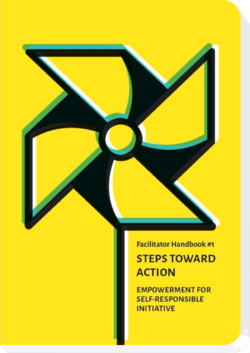Have your participants create an “empathy map” for their initiative, in order to find out more about their target group. Ask them to fill out a poster with the structure shown below. These questions will help them listen, empathize, and make careful observations. On the one hand, the Empathy Map can be helpful in defining topics and questions for a target group; on the other hand once we have answers, it is a good visual way to get the big picture of the social situation related to the project.
 1 hour+x
1 hour+x
 room, paper and pens
room, paper and pens
 5-25 people
5-25 people
 empathy, creativity, design thinking
empathy, creativity, design thinking
Related:
Also interesting::
Handbook #1
Steps toward action

M. Gawinek-Dagargulia, E. Skowron, N. Zimmermann
First handbook of our Handbooks for Facilitators: Read more
Goals
- Participants gain a knowledge of the target groups, audiences, and community members involved in an activity.
- Participants gain analytical skills.
- Participants improve their empathy.
Steps
1. Fill out the following matrix or use the original template by D. Grey/Xplane.
2. Reasoning:
- What patterns, typical behaviors and attitudes, groups or opinions do you observe?
- What is surprising? What is justifying your assumptions?
- Prioritize: What aspect needs more attention, what less?
- Where do you need more information?
- What does that mean according your goals?
- How does your methodology need to respond?
- What does this mean according the acceptance of your activity?
- What aspects do people find interesting and motivating in order to involve?
Empathy Map
|
|
Listening
Influences/Media
1. What influence does the
environment exert?
2. Who are people influenced by?
3. Which media are relevant?
|
Seeing
Environment/Family
1. What does the environment
look like?
2. Who are allies of the group?
3. What opportunities do they have?
|
Saying and doing
External World/Social Interaction
1. What do other people say
about them?
2. How do they behave?
3. What are their hobbies?
|
|
Hopes
Desires/Goals
1. What do people want to achieve?
2. How do they measure success?
3. How can they reach their goals?
4. What do they need in order to
participate?
|
Thinking and feeling
Hopes/Concerns
1. What is important to the
people, to whom am I addressing
my initiative?
2. What are their hopes
and dreams?
3. What moves them?
|
Frustation
Fears/Obstacles
1. What frustrates people in the
target group?
2. What hurdles do they have to
overcome?
3. What risks are they taking?
4. What prevents them from
participating?
|
Variation
- Dig deeper with the task: Designing a persona
- Include the people representing the observed groups, behavior, habits and check your assumptions.
References
Eliza Skowron
Co-founder Working Between Cultures, born in Poland, studies at Jagielloian UniversityKraków (Polen). Facilitator and expert for constructive communication, Anti-Bias, train-the-trainer, author in Competendo.
Handbook for Facilitators: Steps toward Action
M. Gawinek-Dagargulia (ed.), N. Zimmermann (ed.), E. Skowron (ed.) (2016). Steps toward action. Empowerment for self-responsible initiative. Help your learners to discover their vision and to turn it into concrete civic engagement. Competendo Handbook for Facilitators.









